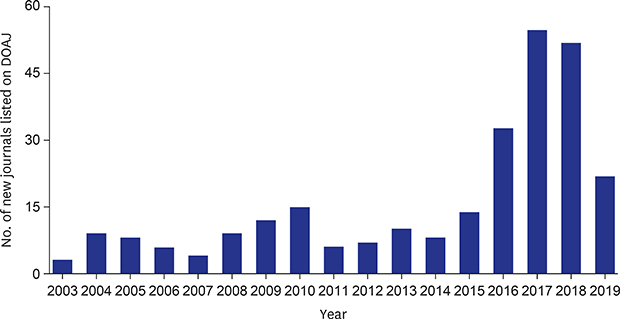1. Smith R. Peer review: a flawed process at the heart of science and journals. J R Soc Med. 2006; 99(4):178–182.

3. Gasparyan AY, Ayvazyan L, Kitas GD. Open access: changing global science publishing. Croat Med J. 2013; 54(4):403–406.

7. Gasparyan AY, Ayvazyan L, Kitas GD. Multidisciplinary bibliographic databases. J Korean Med Sci. 2013; 28(9):1270–1275.

8. Gasparyan AY, Yessirkepov M, Voronov AA, Trukhachev VI, Kostyukova EI, Gerasimov AN, et al. Specialist bibliographic databases. J Korean Med Sci. 2016; 31(5):660–673.

9. Misra DP, Ravindran V, Wakhlu A, Sharma A, Agarwal V, Negi VS. Publishing in black and white: the relevance of listing of scientific journals. Rheumatol Int. 2017; 37(11):1773–1778.

11. Gasparyan AY, Nurmashev B, Voronov AA, Gerasimov AN, Koroleva AM, Kitas GD. The pressure to publish more and the scope of predatory publishing activities. J Korean Med Sci. 2016; 31(12):1874–1878.

12. Gasparyan AY, Kitas GD. Steps towards quality of open access publishing. Mediterr J Rheumatol. 2018; 29(4):184–186.

13. Mukherjee B. Green and gold open access in India. Learn Publ. 2014; 27(1):21–32.

16. Misra DP, Sharma A, Agarwal V. Rheumatology science and practice in India. Rheumatol Int. 2018; 38(9):1587–1600.

17. Misra DP, Wakhlu A, Agarwal V. Letter to the editor: individual researcher and author metrics: a viewpoint from India. J Korean Med Sci. 2018; 33(28):e202.

18. Ghosh K, Ghosh K. Medical research in medical college in India: current scenario and ways to improve it. J Assoc Physicians India. 2019; 67:71–73.
19. Brito R, Rodríguez-Navarro A. Evaluating research and researchers by the journal impact factor: is it better than coin flipping? J Inf. 2019; 13(1):314–324.

20. Satyanarayana K. Open access publication in biomedical research: implications for developing countries. Indian J Med Res. 2004; 120(2):67–69.
21. Nazim M. Bibliometric analysis of gold open access in India. Int Inf Libr Rev. 2018; 50(1):13–23.

22. Seethapathy GS, Santhosh Kumar JU, Hareesha AS. India's scientific publication in predatory journals: need for regulating quality of Indian science and education. Curr Sci. 2016; 111(11):1759–1764.
23. Nazim M, Zia S. Acceptance and adoption of open access publishing by researchers in India. Glob Knowl Mem Commun. 2019; 68(1-2):148–158.

24. Ramam M, Khaitan BK. Expanding our digital archives. Indian J Dermatol Venereol Leprol. 2016; 82(5):475–477.

25. Ghosh SB, Kumar Das A. Open access and institutional repositories — a developing country perspective: a case study of India. IFLA J. 2007; 33(3):229–250.

26. Shukla P, Khan AM. Implications of institutional repositories on contributors' professional and publishing practices: a survey. Int Inf Libr Rev. 2014; 46(3-4):125–136.

27. Bohannon J. Who's afraid of peer review? Science. 2013; 342(6154):60–65.

28. Demir SB. Predatory journals: who publishes in them and why? J Inf. 2018; 12(4):1296–1311.

29. Nagoba B, Davane M, Mumbre S. Is it possible to control publication of predatory journals? Med J Armed Forces India. 2017; 73(3):314–315.

30. Singh HP. Knowledge and attitude of health researchers from India towards paying to publish and open access journals. Indian Pediatr. 2015; 52(3):252–253.
33. Haug CJ. No free lunch - what price Plan S for scientific publishing? N Engl J Med. 2019; 380(12):1181–1185.

37. Habibzadeh F. Open access journals in the Middle East and Iran. J Korean Med Sci. 2019; 34(16):e123.

38. Gasparyan AY, Yessirkepov M, Voronov AA, Koroleva AM, Kitas GD. Updated editorial guidance for quality and reliability of research output. J Korean Med Sci. 2018; 33(35):e247.

40. Mašić I, Begić E, Donev DM, Gajović S, Gasparyan AY, Jakovljević M, et al. Sarajevo declaration on integrity and visibility of scholarly publications. Croat Med J. 2016; 57(6):527–529.







 PDF
PDF Citation
Citation Print
Print




 XML Download
XML Download